By eliminating products made with ingredients that at worst, are toxic and potentially harmful to your health, and at best, irritants or allergens that do not serve you on your path to more healthful living, you will greatly reduce your risk of exposure and may even rid yourself of persistent unexplained health problems.
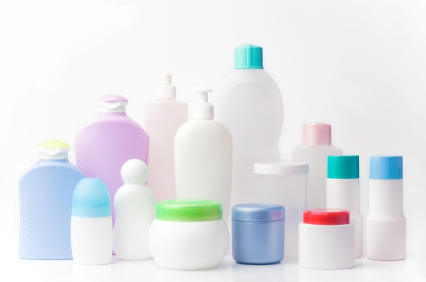 Still not sure what products pose the most harm? Start with the pile or bin of products you use daily. Anything that goes in your mouth or on your skin, are the biggest culprits to watch out for. Toss out toothpastes made with fluoride, mouthwashes made with alcohol, any products made with propylene glycol –as the key ingredient in anti-freeze this substance may be good for your car but not for your mouth or your skin!
Still not sure what products pose the most harm? Start with the pile or bin of products you use daily. Anything that goes in your mouth or on your skin, are the biggest culprits to watch out for. Toss out toothpastes made with fluoride, mouthwashes made with alcohol, any products made with propylene glycol –as the key ingredient in anti-freeze this substance may be good for your car but not for your mouth or your skin!
Alcohol, commonly used in mouthwashes, as well as styling products and even some moisturizers, is drying, changes the pH of the mouth or skin, and strips away the protective mucous membrane in the mouth and throat. Fluorides are industrial waste products created in the production of aluminum, phosphoric acid, and phosphate fertilizers, that have been linked to bone problems, diabetes, thyroid malfunction, and mental impairment.
Avoid soaps, body wash, cleansers, and shampoos made with SLS (Sodium Lauryl Sulfate) or Ammonium Laureth Sulfate. These are harsh detergents that typically strip away your skin and hair’s natural oils, leaving them dry and vulnerable to damage. You can tell when they are present because of the never-ending foamy suds or lather they are specifically designed to create!
Other ingredients to be concerned about in your liquid soap, body wash products, and shampoos: Cocamide EDTA (or similar compounds ending with DEA, TEA or MEA) along with formaldehyde-forming substances such as Bronopol, DMDM hydantoin, Diazo-lidinyl urea, imidazolidinyl urea and Quaternium-15. These are ingredients that have been known to react with other nitrogen-based ingredients to form cancer-causing nitrosamines after absorption.
And a special word of caution regarding “anti-bacterial” liquid hand soaps, body washes, hand sanitizers, or any product made with Triclosan. This chemical is classified by the EPA as a toxic pesticide, measured in parts per billion, and one of its by-products is Dioxin. Its over-use has scientists seriously worried about the rise of ‘super bugs’ — harmful bacteria that are resistant to existing antiseptics and antibiotics.
One other ingredient that you should be very wary of is unidentified “fragrance” oils or compounds (sometimes referred to as Fragrance or Parfum). These are synthetic chemicals made in a lab, designed to mimic the smell of many things that exist in nature –fruits, flowers, trees, and food. The problem is that “fragrance” often contains Phthalates (industrial chemicals used as solvents and plasticizers in cosmetics) which are now known to be endocrine disruptors (wreak havoc with your hormones) and potentially damaging to the kidneys, liver, and lungs, but especially harmful to pregnant women.
Phthalates don’t appear on the ingredients lists of the vast majority of products containing them including so-called “fragrance-free” or “unscented” products that may contain fragrances designed to “cover up” the smell of other ingredients. And many so-called “natural” products often use a combination of essential oils and fragrance oils, so be vigilant about this when checking labels.
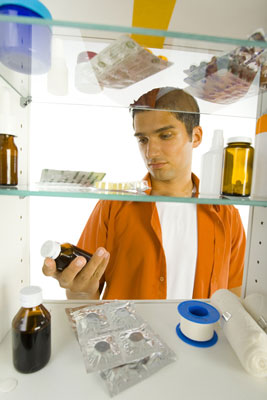 New year’s is usually a great time to give your bathroom cabinet a makeover. If you didn’t get a chance to do a New Year’s Makeover, it’s not too late to start. You can make it part of your spring-cleaning ritual instead. Start now by taking a closer look at what’s inside your bathroom medicine cabinet as well as what may be lurking under the sink or in an adjacent closet. Even the most seemingly innocuous items can contain a veritable of soup of chemicals that may be doing you more harm than good.
New year’s is usually a great time to give your bathroom cabinet a makeover. If you didn’t get a chance to do a New Year’s Makeover, it’s not too late to start. You can make it part of your spring-cleaning ritual instead. Start now by taking a closer look at what’s inside your bathroom medicine cabinet as well as what may be lurking under the sink or in an adjacent closet. Even the most seemingly innocuous items can contain a veritable of soup of chemicals that may be doing you more harm than good.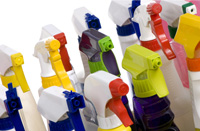 As I promised in my last post, here are the other 3 of 6 suggestions for using commonly found ingredients in your kitchen to create your own green and natural cleaning products and solutions. These were excerpted from an article in the April 2009 issue of Real Simple magazine. Be sure to check out some of the books in the resource section at the end, including a room-by-room guide from Real Simple and continue to share your real-life experiences with these solutions, if you’ve used any of them.
As I promised in my last post, here are the other 3 of 6 suggestions for using commonly found ingredients in your kitchen to create your own green and natural cleaning products and solutions. These were excerpted from an article in the April 2009 issue of Real Simple magazine. Be sure to check out some of the books in the resource section at the end, including a room-by-room guide from Real Simple and continue to share your real-life experiences with these solutions, if you’ve used any of them. Sometimes I wonder if the effort it takes to find a good green cleaner or variety of cleaners is worth the investment of time and money when there are so many safe and natural ingredients that are probably already in your kitchen (or certainly widely available for a low cost) you could use to make your own green cleaning solutions. Below 3 of 6 suggestions taken from an article in the April 2009 issue of Real Simple magazine. Check back in a few days for the other three as well as additional resources.
Sometimes I wonder if the effort it takes to find a good green cleaner or variety of cleaners is worth the investment of time and money when there are so many safe and natural ingredients that are probably already in your kitchen (or certainly widely available for a low cost) you could use to make your own green cleaning solutions. Below 3 of 6 suggestions taken from an article in the April 2009 issue of Real Simple magazine. Check back in a few days for the other three as well as additional resources.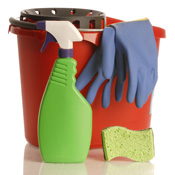 If you happen to own an LCD television or a computer monitor, you’ve probably discovered that cleaners like Windex are useless for getting your screen streak free. However, did you know that a simple solution of one part white vinegar and one part water will get your screen looking as good as new? If you add in one part rubbing alcohol to that solution, then you have a safe and effective cleaner for your windows and mirrors. Not only does this solution work just as well as chemical-based cleaners, it’s simple to make and costs a fraction of store-bought cleaners.
If you happen to own an LCD television or a computer monitor, you’ve probably discovered that cleaners like Windex are useless for getting your screen streak free. However, did you know that a simple solution of one part white vinegar and one part water will get your screen looking as good as new? If you add in one part rubbing alcohol to that solution, then you have a safe and effective cleaner for your windows and mirrors. Not only does this solution work just as well as chemical-based cleaners, it’s simple to make and costs a fraction of store-bought cleaners.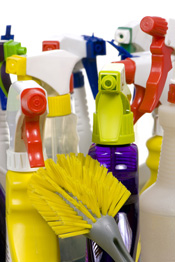 Phosphate-Free & Bleach-Free Laundry Detergents. Phosphates are water-softening mineral additives once widely used in detergents to enhance their stain-removing capabilities. In addition to threatening aquatic and plant life, they can cause nausea, vomiting and diarrhea if ingested, and skin irritation due to their corrosive nature. Bleach is harmful to your lungs and mucous membranes and produces trihalomethanes –toxins linked to cancer– as well as absorbable organic halides, which are harmful to marine organisms. Look for dish and laundry detergents that are free of both phosphates and bleach.
Phosphate-Free & Bleach-Free Laundry Detergents. Phosphates are water-softening mineral additives once widely used in detergents to enhance their stain-removing capabilities. In addition to threatening aquatic and plant life, they can cause nausea, vomiting and diarrhea if ingested, and skin irritation due to their corrosive nature. Bleach is harmful to your lungs and mucous membranes and produces trihalomethanes –toxins linked to cancer– as well as absorbable organic halides, which are harmful to marine organisms. Look for dish and laundry detergents that are free of both phosphates and bleach.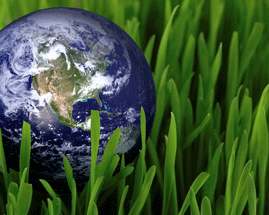 It is truly amazing how the green revolution has changed our lives. We separate our garbage, carpool to work, and even consider buying hybrid cars just to help save Mother Earth. Ironically, many of the everyday household cleaning products we still use are loaded with dangerous chemicals that are anything but environmentally friendly, and potentially quite toxic for us.
It is truly amazing how the green revolution has changed our lives. We separate our garbage, carpool to work, and even consider buying hybrid cars just to help save Mother Earth. Ironically, many of the everyday household cleaning products we still use are loaded with dangerous chemicals that are anything but environmentally friendly, and potentially quite toxic for us.
